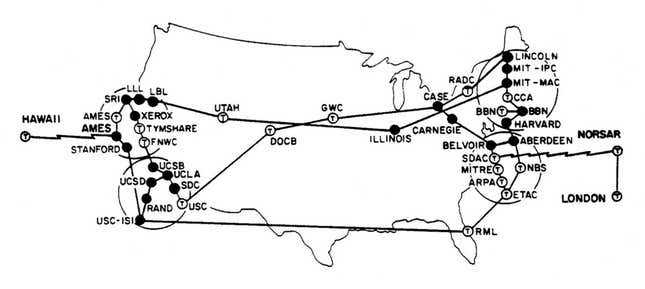Before it became a ginormous ocean of information carrying over a zettabyte of physical transcontinental connections, the internet used to be a lot simpler. Half a century ago, the entirety of ARPANET, predecessor of the internet, was just 45 computers connected to 40 nodes.
The logical map above shows the state of the internet in Sept. 1973. It was charted by Advanced Research Projects Agency (since renamed the Defense Advanced Research Projects Agency) for the ARPAnet Completion Report (PDF), published in Jan. 1978. The earliest players attached to what we now know as the internet were technology departments at research institutions like MIT, Harvard, and UCLA, along with Xerox and NASA’s Ames Research Center. The squares represent the nodes, which were called gateways (the first-generation routers), while the ovals represent the hosts, which were mainframe computers connected to those gateways. One of the most common mainframes at the time was the 36-bit PDP-10, appearing repeatedly in the map above.
Geographically, this logical map would translate to something like this:

APRANET allowed users to transfer files using FTP by the end of 1970, and by 1971, users could dial into a network through an individual computer terminal. By May 1973, 42 hosts were connected to 36 nodes in the US, including a satellite link to Hawaii, according to a similar map recently dug up by David Newbury, who says his father Paul Newbury is a business manager at Carnegie Mellon University’s School of Computer Science.
In Sept. 1973, the network became international: a satellite link connected APRANET to nodes in Norway and London, sending 2.9 million packets of information everyday (which are small units of computer data broken up and sent via the network’s nodes)—up from 1 million per day the year before, according to the book Netizens: On the History and Impact of Usenet and the Internet.
For more early maps of the internet, check out An Atlas of Cyberspaces.
